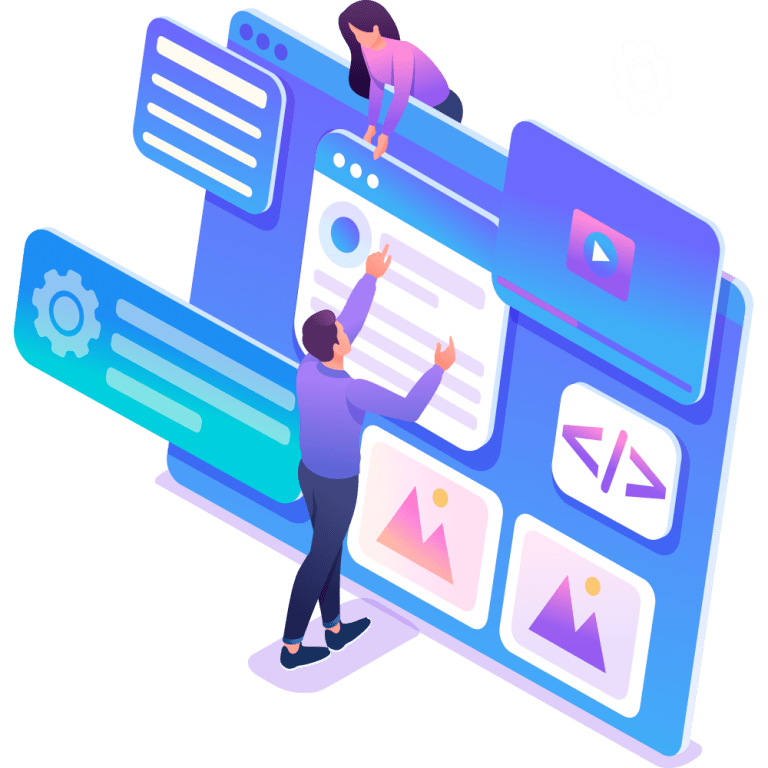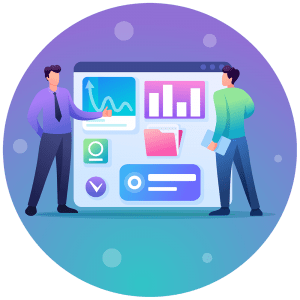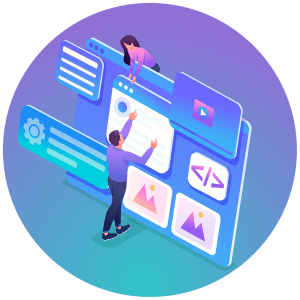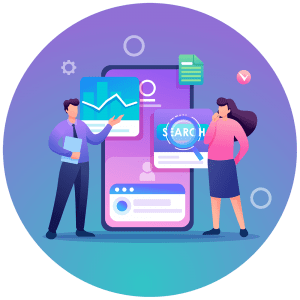Website Design & Development
Transform Your Online Presence with Our Comprehensive Web Design and Development Services


Our Web Design & Development Process
At Loop, we are a website design company that recognizes the critical role a well-crafted website plays in driving business success. A functional, visually appealing website tailored to your specific needs can significantly enhance your customer attraction, lead generation, and revenue growth. Our team of expert web developers works closely with you to grasp your business objectives, crafting custom websites that not only look outstanding but also provide a smooth and engaging user experience. Utilizing the latest technologies and design trends, we ensure your site not only meets aesthetic standards but also excels in search engine performance. Choose our trusted web design services to create a site that delivers tangible results and fosters business expansion. Whether you’re launching a new site or revamping an existing one, we’re committed to helping you achieve your business goals with strategic web design and development.


Step 1:
Understanding Your Business and Website’s Goals and Situation
Our experienced team of Edmonton web developers and website design experts will work closely with you to understand your business goals and situation. We will conduct a thorough needs assessment to determine the purpose of your website, target audience, and main objectives. With this information, we can design and develop a tailored website that meets the unique needs of your business and customers. Our web design and development services are designed to provide scalable, practical, and functional solutions that will help you maximize your online potential and achieve your business goals.
Step 2:
Competitor Analysis
Our team takes a deep dive into your industry to understand the competitive landscape and identify what sets you apart from the rest. Through competitor analysis, we gather insights on the best web design and development strategies to help your business stand out in the market. We use this information to create a unique, practical, and functional website that sets you apart from the competition and serves your customers’ and business’ needs.
Some of the competitor attributes we look at include:
- Tech & Tools
- Site Structure Analysis
- Website Speed & Performance Metrics
- Backlink Tracking & Analysis
- General Usability, Branding & Site Analysis
We compile all of this data together to develop an effective strategy to surpass your competition. A deep understanding of your industry allows us to plan for success.




Step 3:
Planning, Sitemap & Wireframe Creation
Our team of experts in web design and development will use the sitemap, wireframe, and information gathered in the previous steps to create a custom website design that represents your brand and resonates with your target audience. Our focus will be on providing an intuitive user experience, clean design, and fast-loading pages to ensure a seamless and enjoyable browsing experience for your visitors. Our custom web design and development services are tailored to meet the unique needs of your business and achieve your desired goals.
Step 4:
Design: Page Layouts, Review, and Approval Cycle
This is the stage where your website truly comes to life. Our team combines the information gathered in the needs assessment, competitor analysis, and planning phase to create a visually appealing, easy-to-navigate, and functional design that meets the needs of your target audience. We bring your brand to life through the use of relevant colours, images, and logos. As a website design company, customer satisfaction is our top priority, and we work closely with you to ensure that you are delighted with the final product before moving forward.


Get Started with Loop
Why work with Loop Strategic Marketing for your website design and development?
Project Management & Accountability
We set deadlines, and feedback loops that allow us to deliver results beyond your expectations. We get you the results you want, on time.
Constant Communication & Feedback
Feedback is everything, it is your business at the end of the day. If you don’t like something we are doing, we want to know. If you don’t understand why were are doing certain things, we want to explain it to you. Transparency and communication is the most effective way for your project to succeed.
Industry Leading Tools & Technology
The digital world is always changing, staying up to date with industry best practices is a full time job. We make it our mission to build our websites with up to date tools, software, and practices to ensure your project is a success.
Benefits of Our Website Design and Development Services
- CRM / Sales System integrations so you're never missing an opportunity
- SEO Optimized so your website can rank for your targeted keywords
- Strategic design & strategy to convert potential customers
- Copywriting & content is created and curated by us
- Beautiful & functional designs
Frequently Asked Questions
Here are some best practices for web design and development:
- Keep it simple: A cluttered or overly complex website can be overwhelming and confusing for users. Instead, focus on creating a clean, easy-to-navigate design that clearly communicates your message.
- Use clear, concise language: Your website should be easy to understand, even for visitors who may not be familiar with your business or industry. Avoid using jargon or technical language, and aim for a clear, concise writing style.
- Use high-quality images: Visuals are an important element of website design, as they can help convey your message and create a more engaging user experience. Use high-quality images that are relevant to your business and add value to your website.
- Optimize for mobile devices: More and more people are accessing the internet on their smartphones and tablets, so it’s important to design a website that is mobile-friendly. This means ensuring that your website is easy to read and navigate on smaller screens.
- Consider the user experience: The user experience (UX) of your website is critical to its success. Consider how users will interact with your website, and design it with their needs and goals in mind.
By following these best practices, you can design a website that is effective at achieving its goals and delivering a positive user experience.
Was this FAQ Useful?
The success of your website design can be measured through various metrics and tools. Analyze user behavior with analytics tools like Google Analytics to track metrics such as bounce rate, time on site, and conversion rates. High engagement and low bounce rates often indicate effective design. User feedback through surveys or usability tests can provide direct insights into the user experience. SEO rankings for your target keywords can indicate how well your design supports search engine optimization. Load time and mobile responsiveness metrics are also crucial for evaluating the technical performance of your design. Regularly reviewing these metrics can help you understand the impact of your design on user behavior and business goals.
Was this FAQ Useful?
Common mistakes to avoid in web design and development include ignoring mobile responsiveness, overlooking SEO best practices, using excessive animations or complex graphics that slow down the site, neglecting website accessibility standards, and failing to focus on user experience. Overcomplicating the navigation can frustrate users and drive them away. Ignoring content hierarchy and clarity can confuse visitors about your site’s message and offerings. Failing to test the website across different browsers and devices can lead to inconsistent user experiences. Additionally, not updating the content regularly can make your site appear outdated. Avoiding these pitfalls ensures a more effective, user-friendly, and successful website.
Was this FAQ Useful?
Search engine crawlability refers to the ability of search engine bots (also known as crawlers or spiders) to access and navigate a website’s content. When a search engine crawler visits a website, it systematically traverses through the site’s pages, following links and indexing the content it finds along the way.
Crawlability is essential for ensuring that a website’s content is discoverable and indexable by search engines. If a website is not crawlable, certain pages or sections may not be indexed, meaning they won’t appear in search engine results pages (SERPs) when users search for relevant queries.
Several factors can affect a website’s crawlability, including:
- Robots.txt File: The robots.txt file is a text file located in the root directory of a website that instructs search engine crawlers which pages or sections of the site should be crawled and indexed. It can be used to block certain pages or directories from being crawled.
- Meta Robots Tag: Individual pages can include a meta robots tag in their HTML code to specify whether they should be indexed by search engines. Options include “index” (allow indexing) and “noindex” (prevent indexing).
- Internal Link Structure: Search engine crawlers rely on links to navigate through a website’s pages. A well-structured internal linking system makes it easier for crawlers to discover and index all of a site’s content.
- Website Speed and Performance: Slow-loading pages or server errors can hinder crawlers’ ability to access and index a website’s content. Ensuring fast website speed and server reliability can improve crawlability.
- XML Sitemap: An XML sitemap is a file that lists all the pages on a website and provides metadata about each page (such as last modified date and priority). Submitting an XML sitemap to search engines can help ensure that all pages are crawled and indexed.
By optimizing for crawlability, website owners can ensure that their content is effectively indexed by search engines, leading to better visibility and ranking in search results.
Was this FAQ Useful?
The time it takes to design and develop a website can vary depending on the complexity of the website and the size of the web design and development team. On average, it can take 4 to 6 weeks to design and develop an essential website, while a more complex website can take several months.
Was this FAQ Useful?
If you have a small website with only a few pages and aren’t looking at growing significantly, you can likely get by without one. However, if you have a website or business looking to attract a lot of traffic or business, you may need to develop a strategic marketing strategy. This can help you focus your resources on the right things and create campaigns that are more likely to be successful.
Was this FAQ Useful?
If you want to create a WordPress site, the first thing you need to do is install WordPress. You can do this by going to the WordPress website and following the instructions on how to install WordPress on your hosting account. Once you’ve installed WordPress, you can start creating your website by choosing a theme and adding plugins. If you’re looking for support and guidance through this process, reach out and our team will be happy to support.
Was this FAQ Useful?
Effective web design is built on several fundamental principles: simplicity, navigation, responsiveness, consistency, accessibility, and visual hierarchy. Simplicity involves using clean, uncluttered layouts that focus on essential elements, making it easier for users to interact with your site. Navigation should be intuitive, allowing users to find information quickly and easily. Responsiveness ensures your site is accessible on various devices and screen sizes. Consistency in design elements and layout improves usability and brand recognition. Accessibility means your site is usable by people of all abilities and disabilities. Lastly, visual hierarchy guides the user’s attention to important information first. These principles work together to create a user-friendly, engaging, and effective website.
Was this FAQ Useful?
There’s no hard and fast rule for how often you should replace your website. However, we generally recommend doing a full redesign every two to three years, or making smaller updates (such as adding new pages or updating your design) on a more frequent basis. If you’re not sure whether or not it’s time for a new website, reach out and we can chat about it further.
Was this FAQ Useful?
Your website’s design should be updated every 2-3 years to stay current with design trends, technological advancements, and user expectations. However, more frequent updates might be necessary based on performance analytics, user feedback, or significant changes in your business or industry. Regular updates ensure your site remains competitive, relevant, and secure. Additionally, updating your design can improve user experience, support SEO strategies, and address any usability issues. It’s also an opportunity to refresh your content and ensure that your website accurately reflects your brand’s message and values.
Was this FAQ Useful?
Here are a few of the latest trends in web design and development:
- Responsive design: With more and more people accessing the internet on their smartphones and tablets, it’s important to design websites that are optimized for these devices. Responsive design is a design approach that ensures that a website’s layout and content are optimized for different screen sizes and devices.
- Material design: Material design is a design language developed by Google that focuses on creating a consistent, cohesive user experience across all devices. It emphasizes the use of flat design and intuitive, natural interactions.
- Minimalism: Minimalist design involves using a minimal amount of elements, such as text and images, to create a clean and uncluttered look. This trend emphasizes simplicity and functionality, and is particularly popular in web design.
- Microinteractions: Microinteractions are small, interactive design elements that add functionality and personality to a website. Examples include hover effects, loading animations, and notification alerts.
- Artificial intelligence and machine learning: Artificial intelligence (AI) and machine learning are being increasingly used in web design and development to improve the user experience and automate tasks. For example, AI can be used to personalize website content and make recommendations based on user behavior.
These are just a few of the latest trends in web design and development. It’s important to keep an eye on these trends to ensure that your website stays current and relevant. However, it’s also important to consider your own business goals and needs when designing and developing your website, rather than simply following the latest trends for trend’s sake.
Was this FAQ Useful?
There’s no one-size-fits-all answer to this question, as the amount of business you’ll generate from your website will depend on a number of factors. However, studies have shown that businesses with websites tend to grow faster and generate more revenue than businesses without them.
Was this FAQ Useful?
Every business is different, so there’s no one-size-fits-all answer to this question. However, in general, we would say that it’s a good idea for startups to have a website. Websites can help you build credibility, reach more customers, and generate leads and sales. If you’re not sure whether or not a website is right for your startup, reach out and we can chat about it further.
If you’re thinking about getting a website or are ready to take the plunge, we’d be happy to help! We offer affordable website design and development services that will help your business grow. Contact us today to get started!
Was this FAQ Useful?
There are several ways in which a website can help grow your business:
- Increased visibility: A website can help increase the visibility of your business, especially if it ranks well in search engine results. This can make it easier for potential customers to discover your business and learn more about what you offer.
- Greater reach: A website can help you reach a wider audience, both locally and globally. This is especially useful if you have a small or niche business, as it can help you reach customers who may not be able to find your products or services in physical stores.
- Improved credibility: A professional-looking website can help establish credibility and trust with your audience. Customers are more likely to trust businesses with websites, and a well-designed website can make your business look more legitimate and trustworthy.
- Enhanced customer experience: A website can make it easier for customers to learn about your products or services, make purchases, and get in touch with you. This can improve the overall customer experience and lead to increased sales and customer loyalty.
- Streamlined sales process: With an online store, you can streamline your sales process and make it easier for customers to shop with you. This can save you time and resources and help you grow your business more efficiently.
Overall, a website can be a valuable asset for businesses of all sizes, helping them reach more customers, build credibility, and streamline their sales process.
Read more about why your business needs a website.
Was this FAQ Useful?
A comprehensive digital marketing strategy typically involves a combination of several different tactics and strategies.
Search Engine Optimization (SEO) is a strategy that helps to improve the visibility of a website on search engine results pages. This can be achieved through keyword research, on-page optimization, and link building.
Content marketing is a strategy that involves creating and distributing valuable and relevant content to attract and engage with a target audience.
Email marketing is a strategy that involves using email to promote products or services, build relationships with customers, and drive sales.
Social media marketing is a strategy that involves using social media platforms such as Facebook, Instagram and Twitter to promote a business and connect with customers.
Paid advertising is a strategy that involves paying for visibility on different platforms like Google, Facebook, Instagram, and other social media platforms.
A digital marketing plan should be developed based on the specific goals and objectives of the business, as well as the target audience and industry. A digital marketing agency with experience and expertise in strategy development can help to create a tailored plan that will be most effective for a particular business.
A good digital marketing strategy should be continuously monitored and evaluated to ensure that it is achieving the desired results and making the best use of available resources. Thus, it is crucial to regularly review and adjust the strategy of digital marketing as per the changes in the market and customer behavior.
Was this FAQ Useful?
When looking for a website design company, it’s fairly simple. Look for these things:
- Experience – what work can they show you
- Trust – do you feel like they are someone who is honest and trustworthy
- Alignment – do they align with your business goals
Was this FAQ Useful?
The process for designing and developing a website typically includes the following steps:
- Determine the website’s goals and objectives
- Research and plan the website’s design and structure
- Design and create the website’s visual elements
- Develop the website’s functionalities and features
- Test and refine the website
- Launch the website and provide ongoing support and maintenance
Was this FAQ Useful?
The cost of having a website designed and developed can vary greatly depending on a number of factors such as the complexity of the website, the number of pages, and the level of customization required. On average, the cost of a basic website can range from $2,500 to $5,000, while a more complex website can cost upwards of $10,000 or more.
Was this FAQ Useful?
Working with a web design and development company can provide several benefits for your business, including:
- Increased online visibility and exposure
- Improved user experience for your website visitors
- Increased credibility and professionalism for your brand
- Ability to effectively showcase your products or services
- Better search engine optimization for your website, resulting in higher search engine rankings and increased traffic.
Was this FAQ Useful?
Web development is the backbone of your online business presence, involving the coding and programming that powers a website’s functionality. It translates the web design into a live, working site. Developers use HTML, CSS, JavaScript, and other programming languages to bring the design to life, ensuring the site is responsive and performs well across different devices and browsers. Beyond aesthetics, development includes creating the architecture for managing content, securing the site against threats, and integrating with other systems like e-commerce platforms or customer relationship management tools. Effective web development ensures a seamless user experience, supports SEO strategies, and enables scalable, secure online business operations. It’s crucial for maintaining a website’s technical health and operability, directly impacting its success and the user’s satisfaction.
Was this FAQ Useful?
Let's see what you're working with
Tell us a bit about your business, and we will give you a few tips, tricks, and recommendations on the house.
We Provide the Full-Service Website Package
- Responsive Design
- Multi-Device Support
- Adapts to Every Screen Resolution
- Fully Customizable Design
- High Resolution
- Flexible & Versatile
- Fast Load Times
- Ongoing Support & Maintenance Available
- Smooth & Contemporary Design
- E-Commerce Support
- Fully Integrated into your systems
- Conversion Based Design
- On-Site SEO Strategy
- Content & Copy Writing
- Graphic Design
- Branding Packages & Styling Guides
- SSL & Security
- E-Commerce Support
